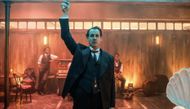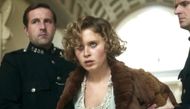Dope Girls is a BBC and Hulu-backed six-part drama that drops viewers into the heart of 1918 Soho, right after World War I. It focuses on Kate Galloway, a widowed mother played by Julianne Nicholson, who builds a nightclub empire from scratch in a chaotic, drug-fueled London club scene.
Inspired by real figures like Kate Meyrick and Billie Carleton, the show mixes fact with fiction to recreate the rise of women-led nightlife and the early British drug underworld. It’s not a slow-paced period drama; this one’s loud, messy, full of color, and built around characters who are constantly pushing back against rules and power.
Set in the clubs, alleys, and flats of post-war London, the show doesn’t actually shoot in Soho. Every inch of that world, from the sweaty basement clubs to the rebuilt Gerrard Street, was filmed in South Wales. Directors Shannon Murphy and Miranda Bowen recreated everything from scratch in studios, castles, and abandoned tunnels.
From Club 33 to the depths of Danton's, the entire set was made to reflect the excess and struggle of the time without looking clean or polished. The filming locations are as central to the show as its characters.
Inside the Welsh locations that transformed into 1918 London for Hulu’s Dope Girls

Despite being set in London’s Soho during the chaotic aftermath of World War I, Dope Girls wasn’t shot anywhere near the capital. Every bar, street, and club you see on screen was built or repurposed in South Wales.
The crew of Dope Girls didn’t even attempt to film in central London; it was too expensive, too busy, and way too restrictive. Instead, the team used an abandoned Nightingale Hospital in Bridgend to build a full-scale indoor version of 1918 Soho. They recreated Gerrard Street from the ground up, complete with fake storefronts, vintage signs, and enough cobblestone to sell the illusion. It was all done indoors to avoid the cold, wet Welsh winter.
Kate Galloway’s cottage, which appears early in the series, was filmed at Merthyr Mawr House near Bridgend. The building was rundown when they found it, so the production team had to repaint and re-wallpaper everything to make it camera-ready. They also digitally altered the outside to make it look like something you'd see in 1918.
The club scenes, especially the ones involving Danton’s, run by the Salucci family, were filmed at Margam Castle in Port Talbot. Although the castle is often used in TV shows, this production went deeper into the cellar than most. The goal was to make it feel unsafe and unwelcoming, a far cry from the glitzy nightclubs people usually associate with that era. They didn’t want polished. They wanted chaos and shadows.
One of the most surprising locations was the disused railway tunnel at Barry Island. Used initially to connect Barry Island to the mainland, the tunnel is now a rifle range. For Dope Girls, it was turned into a hidden underground hideout for women fleeing the streets. They even built and burned a fake tube carriage to make the space look more like a refuge born from destruction. The tunnel's natural dampness and echo added to the eerie feeling they were aiming for.

Trafalgar Square, which appears in the opening episode, was filmed nowhere near central London. That party scene in Dope Girls, set on November 18, 1918, was recreated on a volume stage at Bad Wolf Studios in Cardiff. They used a real fountain and curved LED screens to simulate the massive crowds.
Every street sign, lamppost, and window in the shot was based on actual 1918 references. They even looked up the weather that day and adjusted the lighting to match it. The only thing they changed was the pavement, swapping the dark Tarmac for something less overwhelming on camera.
Finally, New Scotland Yard was recreated inside Swansea Guildhall. While the building is technically from the 1930s, its preserved architecture gave the cold, bureaucratic feel the scenes needed.
It stood in for the police headquarters where Violet Davies faces sexist abuse and eventually goes undercover. The location scouting was extensive, and the team didn’t just pick what looked good; they picked places that felt lived-in and historically believable, even if it meant working with damp tunnels or cold cellars.
Follow for more updates.
